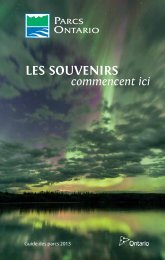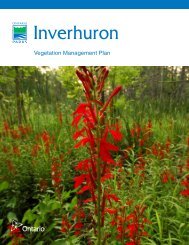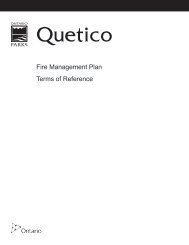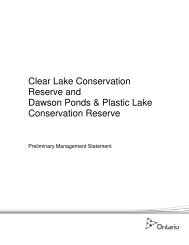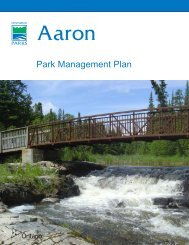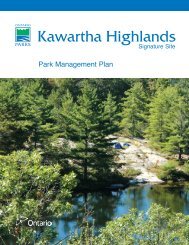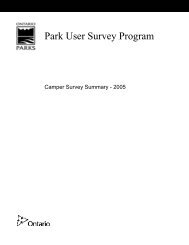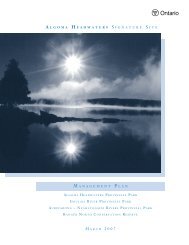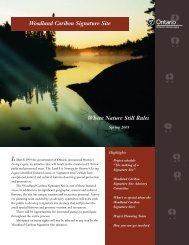Sandbanks Draft Veg Mgmt Plan - Ontario Parks
Sandbanks Draft Veg Mgmt Plan - Ontario Parks
Sandbanks Draft Veg Mgmt Plan - Ontario Parks
Create successful ePaper yourself
Turn your PDF publications into a flip-book with our unique Google optimized e-Paper software.
Summary of Key Management Recommendations<br />
All park staff involved with operations potentially affecting <strong>Sandbanks</strong>’ vegetation<br />
communities will be required to be familiar with this plan’s intent and specific directives.<br />
Operations and Maintenance Policies (Section 3.1)<br />
• Herbicide use is restricted and must be in compliance with provincial regulations<br />
(p. 12)<br />
• Herbicide use must be kept to a minimum, using suggested chemicals and<br />
avoiding areas where park visitors and staff may contact it (p. 12)<br />
• Unless it is unsafe to do so, windthrown and dead standing trees should be left in<br />
place as they serve important ecological functions. Refer to Appendix A for a<br />
decision guide (p. 13)<br />
• When woody material must be removed from the site, it will be used to create<br />
brush piles for restoration, chipped for trail maintenance, or salvaged for firewood<br />
(p. 13)<br />
• Native insect pest outbreaks and diseases are natural processes and should not<br />
be controlled unless significant values within or adjacent to the park are<br />
threatened or the pest is a recent invader to <strong>Ontario</strong>. Forest Health Unit and<br />
zone office staff must be consulted. (p. 14)<br />
• Fire management will be in accordance with existing policies and strategies (p.<br />
15)<br />
• Mowing will be done to the least extent possible, and will not damage natural<br />
vegetation or trees. A mowing plan will be developed (p. 15)<br />
• Leaves and vegetation debris will be disposed of in a composting area (p. 15)<br />
• Native trees and shrubs from a local source will be used for landscaping (p. 16)<br />
Protection and Education Policies (Section 3.2)<br />
• Any proposed developments in nature reserve and natural environment zones<br />
require consultation with zone ecologist (p. 16)<br />
• <strong>Plan</strong>t and seed collection must be approved through a research permit or an<br />
agreement with an Aboriginal user (p. 18)<br />
• The NHE program should continue to include messages about vegetation<br />
stewardship (p. 19)<br />
• All staff must ensure locations of species at risk are kept confidential (p. 16)<br />
Restoration Activities Policies (Section 3.3)<br />
• Habitat destruction in development zones will be assessed and mitigated where<br />
feasible. (p. 20)<br />
• Local native stock will be used for all planting and restoration in the park. (p. 20)<br />
Invasive and Exotic Species (Section 3.4)<br />
• Aggressive invasive species should be controlled when possible following<br />
approved guidelines. (p. 20)<br />
• Invasive species that may pose a threat to park environments should be<br />
monitored. (p. 20)<br />
• Test plots will be established to determine the threat of Purple Loosestrife (p. 21)<br />
• Many ornamental shrubs, periwinkle (myrtle), ground ivy, euphorbias, bellflower,<br />
orange day lily, and sweet violet must not be used in landscaping and should be<br />
removed where established (p. 21)<br />
iii



